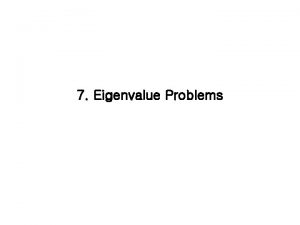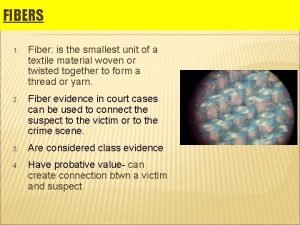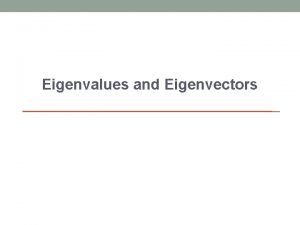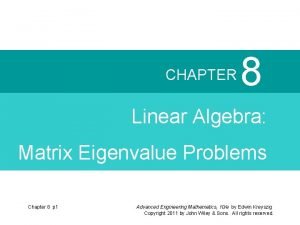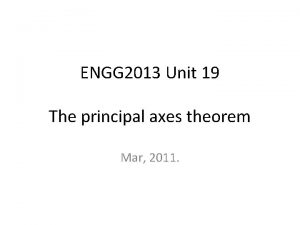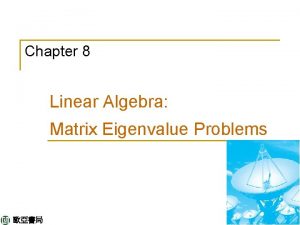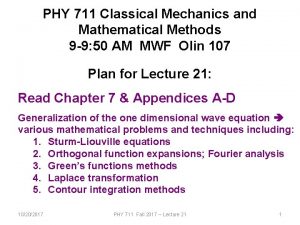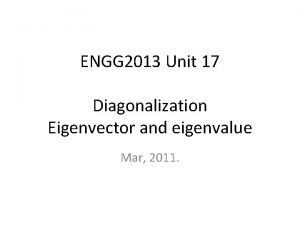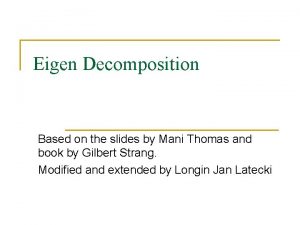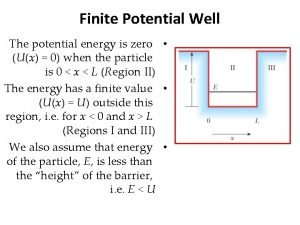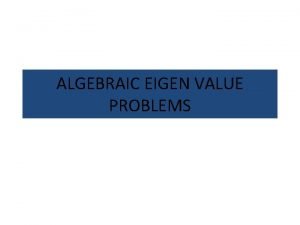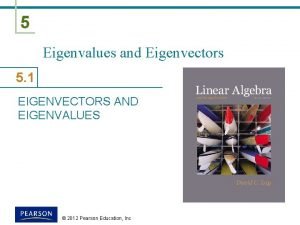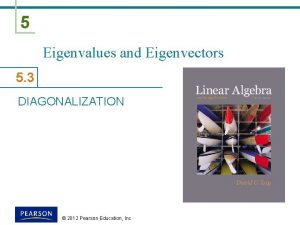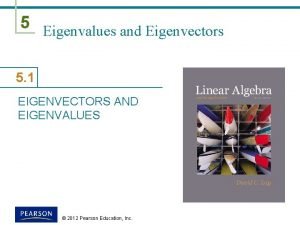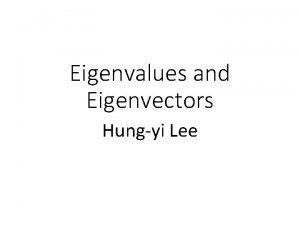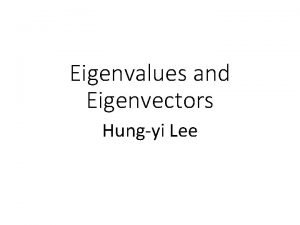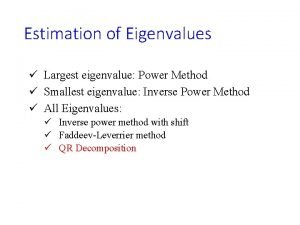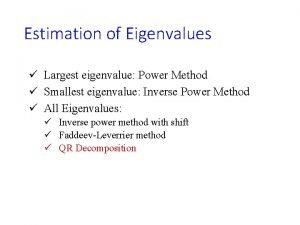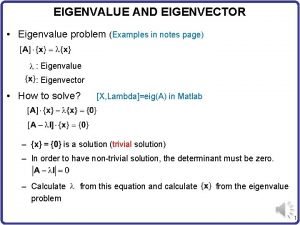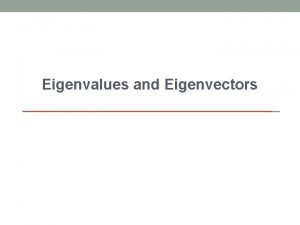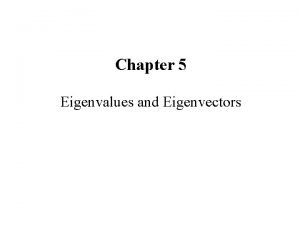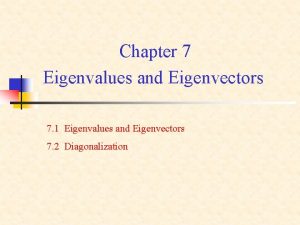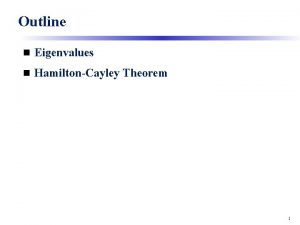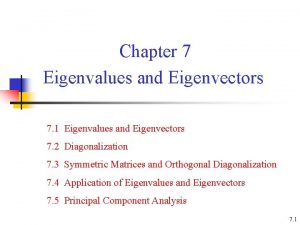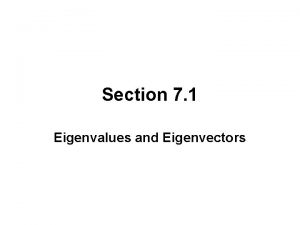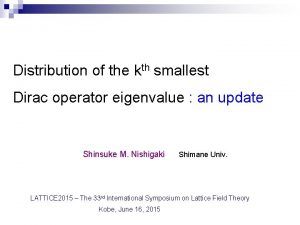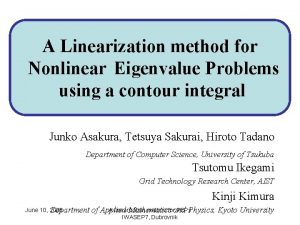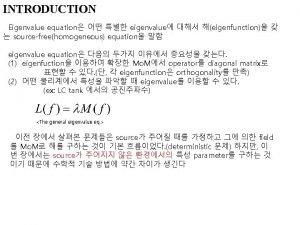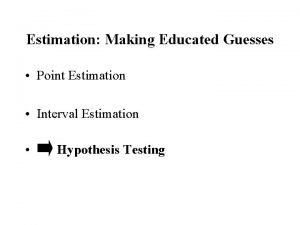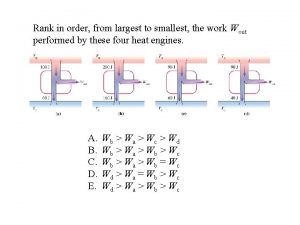Estimation of Eigenvalues Largest eigenvalue Power Method Smallest

































- Slides: 33

Estimation of Eigenvalues ü Largest eigenvalue: Power Method ü Smallest eigenvalue: Inverse Power Method ü All Eigenvalues: ü Inverse power method with shift ü Faddeev-Leverrier method ü QR Decomposition

The Power Method Works if: There is a unique eigenvalue of maximum magnitude! There are n independent eigenvectors corresponding to n eigenvalues

The Power Method Initialize an arbitrary non-zero vector (z(0)) of length n (same as that of the size of the square matrix) Iteration Scheme: The vector (z(k)) converges to the eigenvector corresponding to the eigenvalue of the maximum magnitude! Why? How?

Proof of Convergence: Power Method Denote xi as the eigenvector corresponding to the eigenvalue λi αi’s are the constants Since,

Proof of Convergence: Power Method Denote xi as the eigenvector corresponding to the eigenvalue λi αi’s are the constants Since,

Proof of Convergence: Power Method Denote xi as the eigenvector corresponding to the eigenvalue λi αi’s are the constants Since,

Proof of Convergence: Power Method Denote xi as the eigenvector corresponding to the eigenvalue λi αi’s are the constants Since, For Large k:

Power Method Algorithm Initialize an arbitrary non-zero vector z(0) Iterate: Stop when: Compute the largest eigenvalue as: since

The Inverse Power Method ü Apply power method on matrix A-1 to obtain the largest eigenvalue. Inverse of this eigenvalue is the smallest eigenvalue of A ü Proposition: Inverse of the largest eigenvalue of A-1 is the smallest eigenvalue of A ü For any eigenvalue λi and corresponding eigenvector xi of matrix A: Axi = λixi ü Since λi is a scalar, (1/λi)xi = A-1 xi ü If λi is an eigenvalue of matrix A, (1/λi) is an eigenvalue of A-1 with the same corresponding eigenvector xi

Inverse Power Method with Shift ü Apply power method on matrix (A – αI)-1 to obtain the eigenvalue that is closest to constant α. ü For any eigenvalue λi and corresponding eigenvector xi of matrix A: Axi = λixi ü For a scalar constant α, Axi - αxi = λixi - αxi ü (A – αI)xi = (λi - α)xi, (λi - α) is an eigenvalue of the matrix (A – αI). ü Smallest eigenvalue of matrix (A – αI) corresponds to that eigenvalue of matrix A that is closest in magnitude to the scalar constant α ü This gives an algorithm to estimate an eigenvalue of a matrix that is closest to a given constant!

11

12

13

Faddeev Leverrier Method

15

Similarity Transformation

Computation of Eigenvalues ü Recall: What is an orthogonal matrix? ü Each column vector is orthonormal to each other ü QTQ = I or QT = Q-1 ü A n × n matrix is non-defective if it has n independent eigenvectors (rank n, non-zero determinant, inverse exists, etc. ) ü For every non-defective real matrix A with real eigenvalues, there is an orthogonal matrix Q and an upper -triangular matrix U such that A = QUQT ü If A is complex, Q is unitary such that A = QUQH ü Therefore, A and U are similar matrices, A = QUQT ü The upper triangular matrix U contains the eigenvalues of A on its diagonal.

Computation of Eigenvalues ü All non-defective matrices are similar to upper triangular matrices ü A = QUQT or U = QTAQ, U contains the eigenvalues of A on its diagonal. ü Therefore, a non-defective matrix A can be transformed to an upper-triangular matrix U through similarity transformation and the diagonal elements of U will be the eigenvalues. ü This transformation cannot be achieved in one step. It is achieved through a sequence of similarity transformation using QR-decomposition!

Computation of Eigenvalues

QR-Decomposition a(1) a(2) a(j) q(1) q(2) a(n) q(j) q(n) r(1) r(2) r(j) r(n)

QR-Decomposition: proof by induction

QR-Decomposition: proof by induction

23

QR-Decomposition: proof by induction

25

26

27

QR-Decomposition: Algorithm

Gram-Schmidt Orthogonalization 29

Gram-Schmidt Orthogonalization 30

Gram-Schmidt Orthogonalization 31

Gram-Schmidt Orthogonalization 32

Gram-Schmidt Orthogonalization 33
 Power method smallest eigenvalue
Power method smallest eigenvalue K strategist curve
K strategist curve Biological organization from smallest to largest
Biological organization from smallest to largest Simplest and most common weave pattern
Simplest and most common weave pattern How is house
How is house Biological organization from smallest to largest
Biological organization from smallest to largest Order of cell specialization
Order of cell specialization Smallest to largest level of organization
Smallest to largest level of organization What is the function of smooth endoplasmic reticulum
What is the function of smooth endoplasmic reticulum Largest island smallest continent
Largest island smallest continent 5 oceans
5 oceans 9 metric
9 metric Ecological hierarchy smallest to largest
Ecological hierarchy smallest to largest Eigenvector equation
Eigenvector equation Linear algebra
Linear algebra Example of skew symmetric matrix
Example of skew symmetric matrix Orthogonal matrix example
Orthogonal matrix example Eigenvalue
Eigenvalue Image processing place.com
Image processing place.com Eigenvalue examples
Eigenvalue examples Diagonalize matrix
Diagonalize matrix Orthogonal matrix properties
Orthogonal matrix properties What is the eigenvalue
What is the eigenvalue Potential energy well
Potential energy well Properties of eigenvalues
Properties of eigenvalues Eigen values properties
Eigen values properties Eigenvectors
Eigenvectors Diagonalization of matrix
Diagonalization of matrix Eigen value and eigen vector
Eigen value and eigen vector Eigenvector
Eigenvector What is eigenspace of a matrix
What is eigenspace of a matrix Complex eigenvalues rotation
Complex eigenvalues rotation Eigenvalues
Eigenvalues Eigenvalues
Eigenvalues
